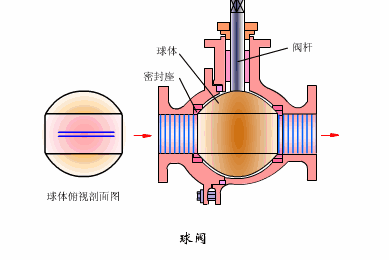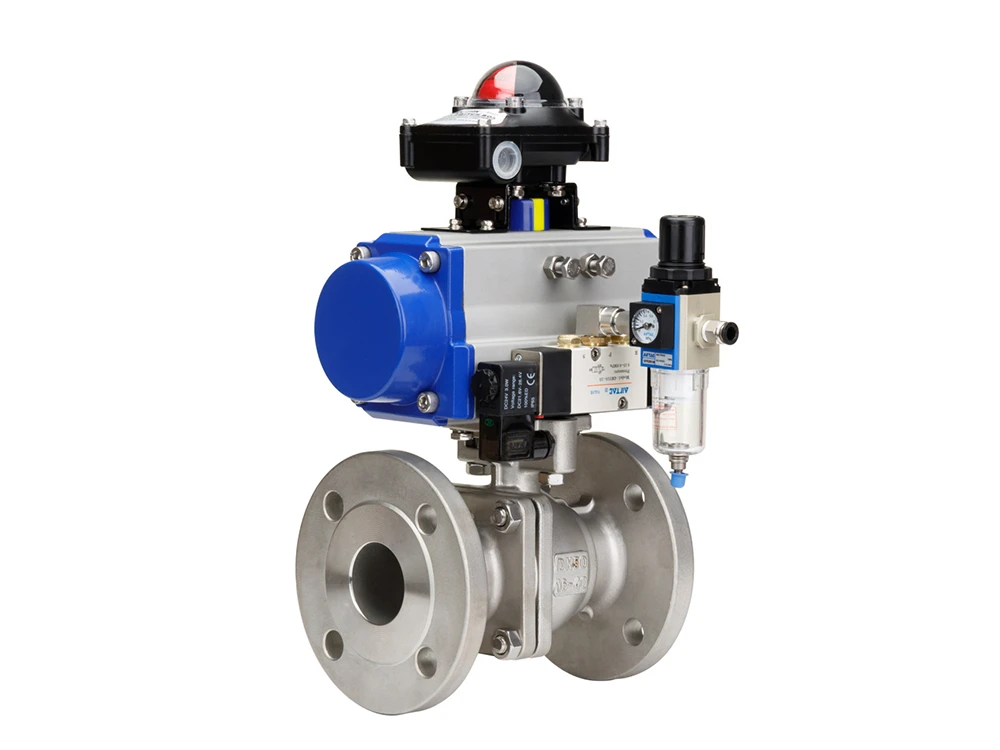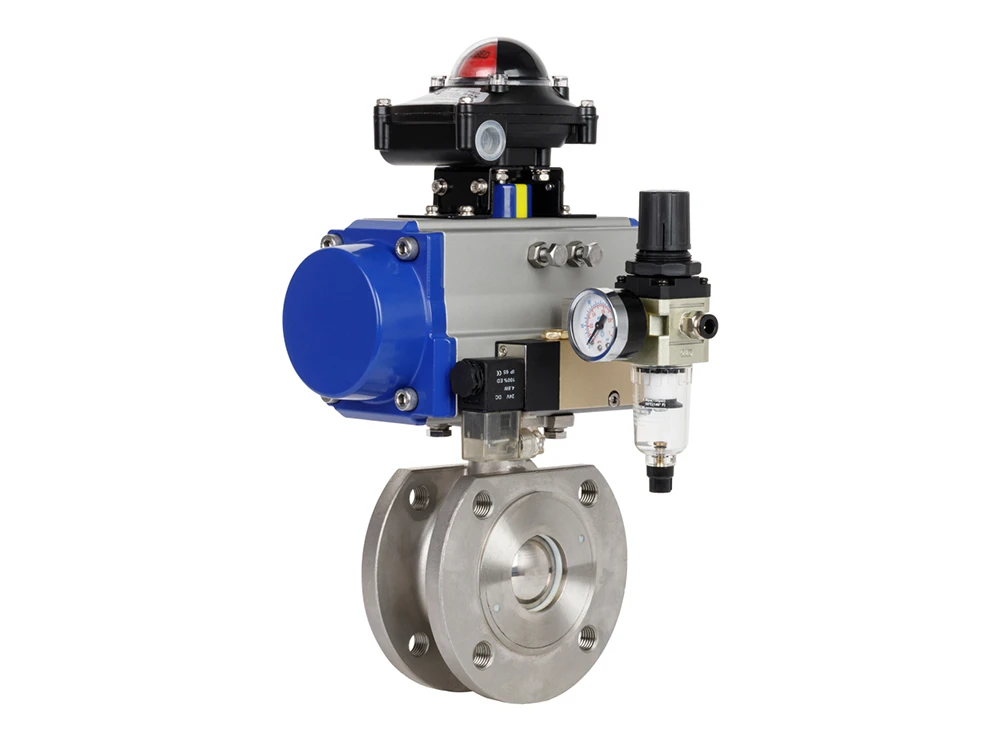What Is A Pneumatic Ball Valve?
Overview of Pneumatic Actuated Ball Valve
The pneumatic ball valve is a combination of a pneumatic actuator and ball valve, instead of manual operation, it not only saves a lot of manpower and material resources but also can be simultaneous control of multiple ball valves. The pneumatic ball valve structure is relatively simple, easy to maintain, relatively high security, has the selection of top quality materials used properly, and has a service life of up to 1 million times. The pneumatic ball valve is evolved from the plug valve. It has the same rotary 90-degree action, the difference is that the plug body is a sphere, with a circular hole or channel through its axis. The spherical surface and passage opening ratio should be such that when the ball is rotated 90 degrees, it should all show a spherical surface at the inlet and outlet, thus cutting off the flow.
Working Principle of Ball Valve
The pneumatic ball valve sphere is transformed from the plug valve, its ball center for the action of rotating 90 °, the sphere around the center line of the valve body for the rotation to achieve open, there is a circular through hole or channel through its axis. When the ball center rotates to 90 ° when the valve is in a tightly closed state, when the actuator works, only a small rotation torque can tightly close the valve so that you can achieve the principle of rapid cut-off. Pneumatic ball valves are mainly used in the rapid cut-off, distribution, and change of the flow of media in the pipeline. The pneumatic ball valve opens and closes quickly, suitable for small and large caliber use. The use of a V-shaped ball can accurately regulate the flow of media.
Structure of Pneumatic Ball Valves
Pneumatic ball valve structure has two distinctions, one is O-type ball spool, O-type ball valve spool for the floating precision castings, the flow channel mouth and the pipeline caliber are the same, mainly used as a cut-off switch. The other is a V-type ball core, which uses a fixed structure, the ball core with a V-shaped cut on the actuator after adding a positioner to achieve the proportion of fiber-containing, granular media regulation.
The pneumatic ball valve is a ball valve with a pneumatic actuator, The pneumatic actuator execution speed is relatively fast, with the fastest switching speed of 0.05 seconds/times, so it is usually also called a pneumatic fast cut-off ball valve. Pneumatic ball valves are usually configured with various accessories, such as solenoid valves, gas source processing triplex, limit switches, positioners, control boxes, etc., to realize the local control and remote centralized control, in the control room you can control the valve on and off, do not need to run to the scene or the high altitude and the danger of bringing manual control, to a large extent, saving human resources, as well as time and security!
Application of Pneumatic Ball Valve
The working principle of a pneumatic ball valve is to rotate the spool to make the valve open or closed. Pneumatic ball valve switch light, small in size, can be made into a large caliber, reliable sealing, simple structure, easy maintenance, sealing surface, and the ball surface is often in a closed state, is not easy to be eroded by the medium, in various industries are widely used.
Pneumatic ball valves and plug valves are the same type of valve, only its closing member is a sphere, the sphere rotates around the center line of the valve body to open and close a valve.
The pneumatic ball valve in the pipeline is mainly used to cut off the speed of fast, distribution and change the direction of the flow of media.
Type of Pneumatic Ball Valve
Pneumatic ball valves can be divided into structural forms
First, the floating pneumatic ball valve
A pneumatic ball valve ball is floating, under the action of medium pressure, the ball can produce a certain displacement and is tightly pressed on the sealing surface of the outlet end, to ensure that the outlet end of the seal is.
The floating pneumatic ball valve structure is simple and has good sealing, but the ball to withstand the load of the working medium is all transferred to the outlet seal, so we should consider whether the seal material can withstand the ball medium workload. This structure is widely used in low-pressure ball valves.
Second, the trunnion ball pneumatic ball valve
The pneumatic ball valve ball is fixed, and the pressure does not move. Fixed ball ball valves are with a floating seat, by the media pressure, the seat moves so that the seal ring is tightly pressed on the ball to ensure sealing. Usually equipped with bearings on the upper and lower shafts with the ball, the operating torque is small and suitable for high-pressure and large-diameter valves.
To reduce the operating torque of the pneumatic ball valve and increase the reliability of the seal, in recent years the emergence of oil-sealed ball valves, both in the sealing surface of the pressure between the injection of special lubricant to form a layer of oil film, that is, to enhance the sealing, but also reduces the operating torque, more suitable for high-pressure large-diameter ball valves.
Third, elastic ball pneumatic ball valve
The ball of the pneumatic ball valve is elastic. Ball and seat seals are made of metal materials, and sealing specific pressure is very large, Depending on the medium itself the pressure has not reached the sealing requirements, and must be applied to external forces. This valve is suitable for high-temperature and high-pressure media.
An elastic ball is in the lower end of the inner wall of the ball to open an elastic groove and get elastic. When the channel is closed, the wedge-shaped head of the valve stem is used to make the ball rise open and the valve seat is pressed to achieve sealing. In the rotation of the ball before the release of the wedge head, the ball and then return to its original shape, so that the ball and the seat of the valve seat between the appearance to a very small gap, you can reduce the friction of the sealing surface and the operating torque.
Pneumatic ball valves can be divided into straight-through, three-way, and right-angle types according to their channel position. The latter two types of ball valves are used to distribute the medium and change the direction of flow of the medium.








